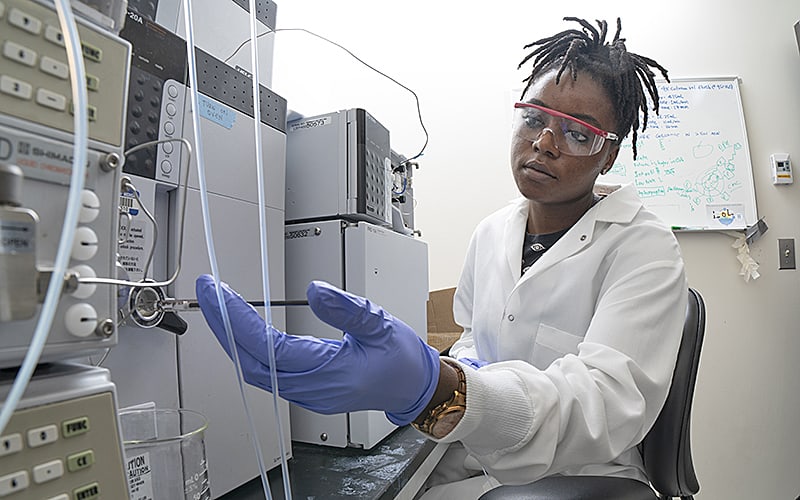Cellular Engineering

From using T-cells to fight cancer to using microbes to produce biofuels, cellular engineering is a growing area of chemical engineering research at Michigan. Our department is also uncovering new cellular-level information – for example, how cellular signaling occurs or how cancer cells travel through the bloodstream – that can be used to fight diseases. This new knowledge can also be used in tissue engineering.
Maciek Antoniewicz
Professor Maciek Antoniewicz and his group develop and apply cutting-edge quantitative analysis tools and advanced analytical and cell culture methods to study and redirect cellular metabolism. In their interdisciplinary research program, they focus on significant problems in areas related to the microbiome (e.g. natural and synthetic microbial communities), biotechnology (production of biofuels and pharmaceuticals) and medicine (cancer, diabetes, and obesity). They develop and make use of modern techniques in metabolic engineering, adaptive evolution, metabolic profiling, metabolic flux analysis, stable-isotope labeling, mass spectrometry, and computational biology.
Brendon Baker
The Baker lab studies how structure and mechanics of the cellular microenvironment guide fundamental cell processes such as migration, proliferation, and extracellular matrix synthesis. To do so, we use microfabrication technologies to create synthetic biomaterials that mimic the 3D, fibrous nature of stromal or interstitial tissues. Combined with molecular tools, live imaging, microfabrication/fluidic techniques, and multi-scale mechanical characterization, these materials allow us to model, study, and control the interactions between cells and their surroundings. Ultimately, we aim to 1) shed insight into extracellular matrix-mediated diseases such as cancer and fibrosis and 2) use material cues to direct cell function for tissue engineering and regenerative medicine applications.
Sasha Cai Lesher-Pérez
Professor Sasha Cai Lesher-Pérez joined the Chemical Engineering faculty at the University of Michigan as an Assistant Professor in August 2022. The Lesher-Pérez Research Group leverages microfabrication, microfluidics, biomaterials and tissue engineered models to build microphyisiological models to study biorhythms and their role in disease and health mechanisms.
Xiaoxia (Nina) Lin
Professor Nina Lin and her group investigate communities of microbes and engineers symbiotic relationships among them to process chemicals, such as turning plant material into biofuels.
Deepak Nagrath
Nagrath Lab (Systems Biology of Human Diseases)
Sunitha Nagrath
Professor Sunitha Nagrath’s research focus is the development of advanced MEMS tools for understanding cell trafficking in cancer through isolation, characterization and study of circulating cell in peripheral blood of cancer patients. Her group works on isolating and studying rare cells from cancer patients. These studies will progress to the design and development of smart chips that use microfluidics and nanotechnology to make an impact in medicine and life sciences.
Lonnie Shea
Professor Lonnie Shea’s laboratory is applying systems engineering approach to develop multi-functional biomaterial systems that can provide multiple cues that direct cell fate. In conjunction, a systems biology approach is applied to molecularly dissect cellular processes and identify the key drivers of cell fate that can be targeted with the biomaterial systems.
Peter Tessier
The Tessier lab aims to develop next generation technologies for designing, discovering, engineering, characterizing, formulating and delivering monoclonal antibodies and other biologics for molecular imaging, diagnostic and therapeutic applications. Their research in the area of cellular engineering is focused on using antibodies to control stem cell reprogramming and differentiation for applications including eye-related disorders, diabetes and neurodegenerative diseases.
Greg Thurber
Professor Greg Thurber and his group study molecules used to image diseased tissue, such as tumors, Alzheimer’s plaques, and arterial plaques. The same features that allow imaging molecules to target particular tissues can also be turned to targeted drug delivery. With a fundamental understanding of how molecules distribute in the body, the team can design better molecules for imaging and therapies.
Angela Violi
Henry Wang
Professor Henry Wang is interested in biopharmaceutical engineering including personalized medicine, rapid vaccine and drug development, and regulatory science and engineering for biomedical innovation. His group is also developing a systematic approach for integrating chemical and biological reactions to produce energy and other products from biomass.
Fei Wen
Professor Fei Wen’s research goal is to harness the immunological power of T-cells to fight cancer and infections and to control their undesired behaviors associated with autoimmunity and allergies. Her group is also engineering microbes that are capable of converting plant biomass to biofuels, such as ethanol.